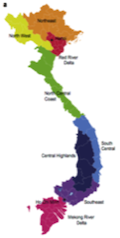Abstract
###Background Enterovirus 71 subgenogroup C4 caused the largest outbreak of Hand, Foot and Mouth Disease (HFMD) in Vietnam during 2011–2012, resulting in over 200,000 hospitalisations and 207 fatalities.
###Methods A total of 1917 samples with adequate volume for RT-PCR analysis were collected from patients hospitalised with HFMD throughout Vietnam and 637 were positive for EV71. VP1 gene (n=87) and complete genome (n=9) sequencing was performed. Maximum-likelihood phylogenetic analysis was performed to characterise the B5, C4 and C5 strains detected.
###Results Sequence analyses revealed that the dominant subgenogroup associated with the 2012 outbreak was C4, with B5 and C5 strains representing a small proportion of these cases.
###Conclusions Numerous countries in the region including Malaysia, Taiwan and China have a large influence on strain diversity in Vietnam and understanding the transmission of EV71 throughout Southeast Asia is vital to inform preventative public health measures and vaccine development efforts.
